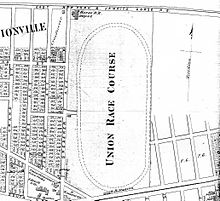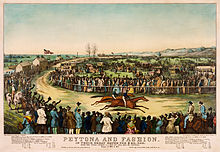A match race is a race between two competitors, going head-to-head.

Belmont Park is a thoroughbred horse racetrack in Elmont, New York, United States, just east of the New York City limits. It was opened on May 4, 1905, and is one of the major tracks in the northeastern United States.

Woodhaven is a neighborhood in the southwestern section of the New York City borough of Queens. It is bordered on the north by Park Lane South and Forest Park, on the east by Richmond Hill, on the south by Ozone Park and Atlantic Avenue, and the west by the Cypress Hills neighborhood of Brooklyn.

Sports in the New York metropolitan area have a long and distinguished history.
Tom Durkin is a semi-retired American sportscaster and public address announcer specializing in Thoroughbred horse racing. He was the race caller for NBC Sports from 1984 through 2010 and served as announcer for the New York Racing Association from 1990 until retiring in 2014. For his career-long dedication, he was awarded the Eclipse Award of Merit in January 2015.
The Withers Stakes is a Grade III American Thoroughbred horse race for three years old horses over the distance of 1+1⁄8 miles on the dirt scheduled annually in February at Aqueduct Racetrack in Queens, New York. The event currently carries a purse of $250,000.
Dexter Park was a public park located in the neighborhood of Woodhaven, Queens, New York City, just north of Eldert Lane and Jamaica Avenue, not far from the borough line with Brooklyn. It had a long early history starting in the 19th century as a recreational park, which replaced a racetrack.

Boston (1833–1850) was an outstanding Thoroughbred racehorse and a leading sire in North America three times from 1851 to 1853. He started in about 45 races, winning 40, including 15 in succession. Boston was later one of the initial inductees into the Hall of Fame.

Fashion (1837–1860) was a Thoroughbred four-mile racemare that defeated Boston and set a record of 7:32½, for that distance, before the American Civil War. Until her meeting with Peytona, Fashion had started 24 times, and won 23 races, 14 of which were of four-mile heats, 6 of 3-mile heats and 3 of 2-mile heats for earnings of $35,600.

American Eclipse (1814–1847) was an undefeated American Thoroughbred racehorse, who raced when three- to four-mile heats were common.

Gravesend Race Track at Gravesend in Brooklyn, New York was a Thoroughbred horse racing facility that opened in 1886 and closed in 1910. The track was built by the Brooklyn Jockey Club with the backing of Philip and Michael Dwyer, two wealthy racing stable owners known as the Dwyer Brothers. Philip, the controlling shareholder of the Brooklyn Jockey Club, served as its president.
The Tremont Stakes is a Listed American Thoroughbred horse race run annually for two-year-olds over the distance of 5+1⁄2 furlongs on the dirt in early June at Belmont Park in Elmont, New York. The event carries a purse of US$150,000.

Sheepshead Bay Race Track was an American Thoroughbred horse racing facility built on the site of the Coney Island Jockey Club at Sheepshead Bay, New York.
The Gallant Fox Handicap is a discontinued Thoroughbred horse race in New York City which was run annually from 1939 through 2009. Hosted by the now defunct Jamaica Race Course in Jamaica, Queens from inception through 1957, it was then moved to Aqueduct Racetrack in the Borough of Ozone Park, Queens, New York. The race was open to horses age three and older and although contested on dirt at various distances for the most part it was a longer distance race.
Lady Lightfoot, was an American Thoroughbred racing mare.

Morris Park Racecourse was an American thoroughbred horse racing facility from 1889 to 1904. It was located in a part of Westchester County, New York that was annexed into the Bronx in 1895 and later developed as the neighborhood of Morris Park. The racecourse was the site of the Belmont Stakes from 1890 through 1904 as well as the Preakness Stakes in 1890.
Shaun Xavier Bridgmohan is a jockey in American Thoroughbred horse racing.

The Brighton Beach Race Course was an American Thoroughbred horse racing facility in Brighton Beach, Brooklyn, New York, opened on June 28, 1879 by the Brighton Beach Racing Association. Headed by real estate developer William A. Engeman, who owned the Brighton Beach Hotel, the one-mile race track was located in back of the hotel and bounded by Ocean Parkway on the west, Neptune Avenue on the north, Coney Island Avenue on the east, and Brighton Beach Avenue on the south. An instant success, the race track drew wealthy patrons from New York City, and harness racing was introduced there in 1901.
Pastille was a British Thoroughbred racehorse and broodmare who won two British Classic Races. In a career which lasted from April 1822 until November 1824, she won eight of her thirteen races and was placed second or third in the other five. On her second racecourse appearance in she became the first filly to win the 2000 Guineas at Newmarket and went on to win the Oaks Stakes at Epsom Downs Racecourse a month later. She won once as a four-year-old in 1823 and was unbeaten in three starts in 1824. After her retirement from racing she had some success as a broodmare.

Theodore was a British Thoroughbred racehorse and sire best known for winning the classic St Leger Stakes in 1822 at odds of 200/1. Trained in Yorkshire by James Croft, he won the second of his two races as a two-year-old and showed good form the following year, winning races at Catterick, York and Newcastle. His St Leger prospects, however, appeared remote after health problems and poor performances in training gallops. His upset win in the classic, followed by a poor run over the same course and distance two days later, attracted a great deal of comment and suspicions of race-fixing, although none of the allegations was ever proved.












